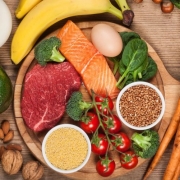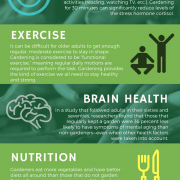From Burgers to Broccoli: How to Love Eating Healthy

Habits take a long time to form, and aren’t easily altered overnight. Why should intelligent eating be any different? Food cravings are powerful! Even if you start to eat healthier, how can you actually enjoy healthier foods?
Like any life change, it’s a process. You need to not only change your diet, but your thinking around how to love eating healthy. And that doesn’t just mean what’s going on in your head. You need to start thinking of your stomach as a second brain—and feed it wisely.
You’re probably aware eating healthy has numerous health benefits. Increased energy, maintaining a healthy weight, a healthy heart, and having the building blocks for your whole body. The problem isn’t in knowing the benefits of eating healthy. It’s learning how to make yourself like healthy food. You can figure out how to love eating healthy by answering a few questions.
How Can I Practice Intelligent Eating When It’s So Hard?

Alright, so going cold turkey isn’t always the best approach to quitting something. You can’t just give up fried chicken, burgers, and pizza every night and expect to jump into a plate of kale. You would most likely fail. You also can’t expect to ease into a new habit without a plan to adjust your tastes and habits.
Changing your preferences to healthier options has a few roadblocks. Some are a function of the busyness of modern life. A trip to the grocery store or farmers market won’t mean much after work when you’re tired and stressed out. The fast-food drive-through can just be too tempting.
Other roadblocks come built into the human body. Example: Your taste buds are often subject to a process called neophobia. This is a fear of trying new or different things.
Like a lot of hang ups around food, there’s an evolutionary component to this process. Our ancestors didn’t always know which foods were healthy, and which foods might kill them. Once they found a food source wasn’t harmful, our ancestors would develop a taste for it. Eventually they might even enjoy it.
Most people aren’t foraging for food these days. So, you don’t have to worry about consuming something mysterious and potentially poisonous. But, the evolutionary defense mechanism remains.
There’s good news, though. First, eating spinach won’t kill you. And second, the more you eat a certain type of food, the more you acquire a taste for it. Even to the point of enjoyment.
You can also pair new foods with your old favorites. Maybe even replacing an unhealthy food with ingredients that are better for you. Instead of mayonnaise on your next sandwich, try spreading avocado. Instead of getting the meat lover’s pizza, try the vegetarian. If you start eating healthier foods with favorites you already enjoy, you’ll find that the new, healthy foods might start being tasty by association.
What Exactly is a Healthy Diet?
Whether or not you are actually on a strict diet, you need to eat a mix of healthy, nutrient-rich foods. Start with whole fruits and vegetables. Half of what you eat should be made up of these nutritious plants. And vegetables should take up the larger share. Whole grains and lean protein should make up the other half, with grains taking up the larger portion. This is followed by a side of dairy like cheese, milk, or yogurt. If you follow this general outline every day, you should receive a foundation of necessary nutrients.
More important than nailing the ratios of healthy food groups though, is to control your portions and limit your intake of overly processed foods. Chips, cookies, soda, frozen dinners, fast food, and the like can all contain unhealthy amounts of sugar, fat, and salt.
A diet high in fat and rich in sugar is harder for your body to process on many levels. Sugar tastes great, but doesn’t do much to curb hunger. So, it takes an awful lot of sugary, processed foods to make you feel full. Fat and sugar also trigger the pleasure receptors in the brain.
For many of our distant ancestors, it was rare to come across calorie-dense foods. Those they found would provide much needed sustenance, and any calories the body didn’t convert to quick energy was stored as fat for future use. Gorging on sweets and fats whenever they were available gave humans an evolutionary advantage.
Now, this process works against us. Foods high in sugar and fat are everywhere, and, instead of feasting, the challenge now is to limit your intake. That means paying attention to those ingredient labels!
Better yet, try to eat whole and fresh foods as often as possible. You don’t have to search an ingredient label when you buy fresh produce, meat, and fish in the store. That’s because there are no added ingredients. When it comes to grains, try to stick with whole grains like whole wheat, oatmeal, and brown rice.
How Do Healthy Foods and the Gut-Brain Axis Combine to Create Intelligent Eating?
A remarkable amount of research has recently expanded on the links between the brain and microbiome. There isn’t just evidence a healthy microbiome can influence weight and help deal with occasional stress. It may play a role in regulating mood and maintaining overall health.
There is a vast network of millions of nerves and chemical interactions that connect the gut to the brain. This is commonly referred to as the gut-brain axis.
The vagus nerve is one of the biggest nerves connecting your gut and brain. Signals travel in both directions along this pathway, from the gut to the brain and back. Research has shown these signals can be impacted by hormones and by what’s happening in your gut. That includes what kind of bacteria you’re cultivating with your diet. Since changing your diet changes the type of bacteria in your gut, you can help maintain the efficiency and health of this important connection.
Here’s an example of how diet can impact your gut-brain axis.
Some of the chemicals produced in your gut are called short-chain fatty acids (SCFA). Among the most important for the gut-brain axis are butyrate and propionate. These SCFAs (and many others) are the product of gut bacteria fermenting fiber. So, by eating more fiber-rich fruits and vegetables, it can help your body make SCFAs.
And that’s a good thing because these short-chain fatty acids help provide energy to the cells of your colon. There’s also evidence that butyrate helps in forming the blood brain barrier. Some studies have even shown butyrate to have a role in maintaining neurological health.
Meanwhile, an increase in propionate in the gut has been shown to lower the amount of activity in the pleasure centers of the brain when exposed to high energy, unhealthy food. Scientists detected considerably weaker electrical impulse activity in the nervous systems of test subjects that had higher fiber diets. Because there was less of a reward response in the brain, they literally found the unhealthy food less appealing!
Reducing your enjoyment of junk food isn’t the only way supporting your gut-brain axis with diet could help you manage your weight. The flora in your gut can also play a large role.
There are literally trillions of microbes in your gut. Two of the most important are Firmicutes and Bacteroidetes. Studies have shown that these two play a significant role when it comes to managing weight.
Consuming high amounts of fat and sugar tends to boost the levels of Firmicutes, while limiting the presence of Bacteroidetes. With that dietary pattern, it might not be surprising that higher levels of Firmicutes have been detected in the microbiomes of obese people.
But the gut microbiome isn’t fixed. When obese people ate diets lower in fat and sugar, they lost weight. And, sure enough, samples of their microbiomes would reveal a decrease in Firmicutes and an increase in Bacteroidetes.
What are Some Tips for Learning How to Love Eating Healthy?
Your best bet is to start small, slow, and to have a plan. Here are six tips to get you started.
- Once or twice a week, plan a meal with a healthy vegetable you’ve never tried before, and experiment with how you prepare it. Sure, you may not like steamed broccoli. But what if it’s sautéed in a bit of olive oil, and tossed with sea salt, fresh ground pepper, and lemon juice? Swiss chard may not be your thing, but use sautéed leaves for a filling in enchiladas, or even raw in a smoothie? You might make a delicious discovery. And, remember, cooking at home is always better (for your health and for your wallet) than going out to eat.
- Next time you have a salad, try making a simple vinaigrette. Mix up olive oil, vinegar, and whole-grain mustard—three parts oil to one part vinegar with a dab of mustard works best. You’ll be skipping the bottled salad dressing that most likely has a lot of extra sugar and calories.
- Instead of buying sweetened cereal or yogurt, simply add your own fresh fruit. You’ll find it’s just as tasty, and you’ll feel good about the choice.
- Feed your microbiome. Some of the best foods for increasing healthy gut bacteria are high in fiber and those rich in omega-3 fatty acids like fish and eggs. Maybe skip the processed smoked salmon or lox, and try grilling salmon with olive oil and fresh herbs on top.
- Try introducing probiotics into your diet. Probiotics are foods that contain active microorganisms. When you consume these foods, you introduce healthy bacteria into your gut that can help maintain a healthy balance of microbes to support gut health. Common probiotic foods include yogurt, kombucha, kefir, kimchi, sauerkraut, and sourdough bread.
- Grow a garden. Nothing quite beats the taste of a fresh-off-the-vine heirloom tomato you watched grow all summer. It’s not really fair to compare homemade pesto to the store-bought version either. You can get a real sense of accomplishment that comes with growing your own food, too. And kids might be more likely to sample the literal fruits of their labor. If you don’t have the yard space for a garden, you can grow some plants and herbs in smaller pots and containers. If that doesn’t work, try hitting the farmers market, or signing up for community garden.
So, now you’ve learned tips about how to love eating healthy. It’s not easy to switch your food cravings to healthier options, and it takes repetition and commitment. Luckily, the steps aren’t complex. It all comes down to making newer food palatable for you.
But you can only figure out what you enjoy if you keep trying new things. The internet is your friend here. For every type of new food, there are a hundred different recipes to explore. Pick one and start your intelligent eating journey today.
References
https://www.cdc.gov/obesity/data/prevalence-maps.html
https://www.hsph.harvard.edu/nutritionsource/healthy-eating-plate/
https://www.choosemyplate.gov/
https://www.scientificamerican.com/article/how-sugar-and-fat-trick-the-brain-into-wanting-more-food/
https://microbewiki.kenyon.edu/index.php/Gut_Microbiota_and_Obesity
https://www.ncbi.nlm.nih.gov/pmc/articles/PMC4756104/
https://www.ncbi.nlm.nih.gov/pubmed/26868600
https://www.ncbi.nlm.nih.gov/pubmed/27169834
















